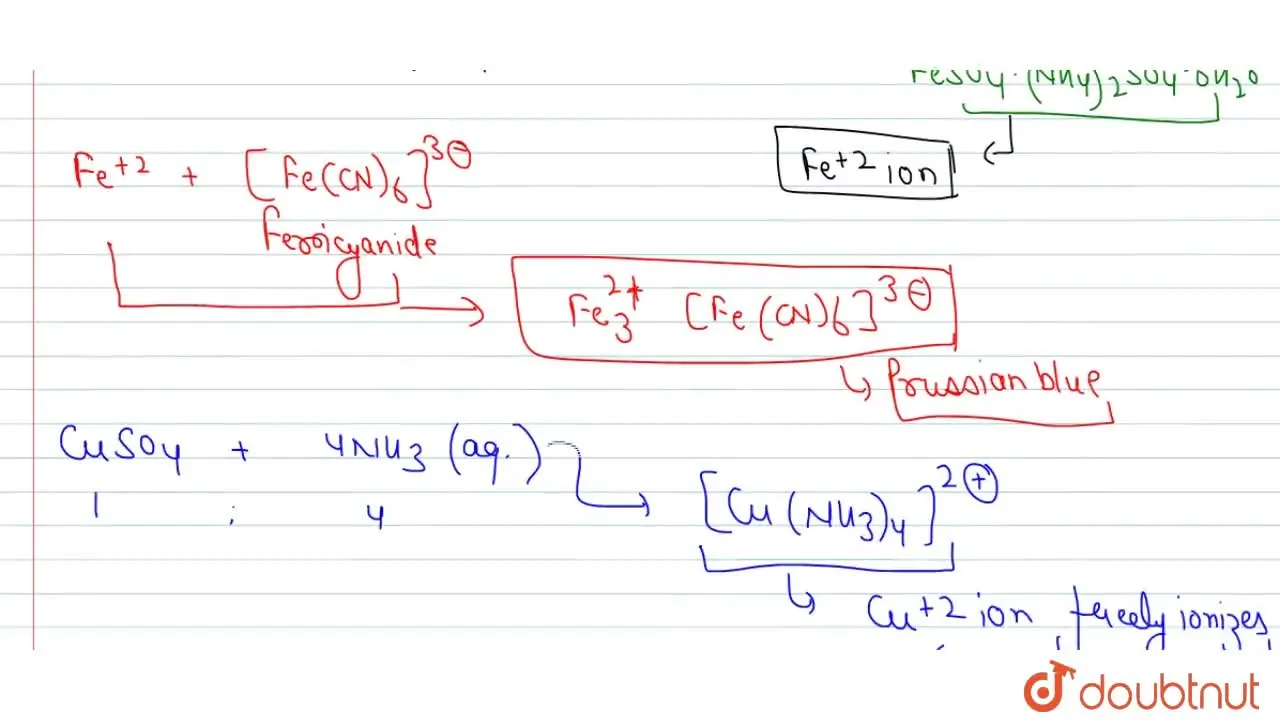FeSO4 solution mixed with (NH4)2SO4 solution is 1:1 molar ratio gives the test of Fe2+ ion but CuSO4 solution mixed with aqueous ammonia in 1:4 molar ratio does not give the test of Cu2+ ion. Explain why?
(a). FeSO4 and (NH4)2SO4 in 1:1 molar ratio form a double salt, called Mohr's salt.
FeSO4.(NH4)2SO4.6H2O which ionises in aqueous solution to give Fe2+ ions. Hence it gives the test of Fe2+ ions.
Test of Fe2+ ions:
(i). Fe2++[Fe2+(CN)6]4−Ferrocyanide ion→Fe2+3[Fe(CN)6]4−Ferro-ferro cyanide
(ii). Fe2++[Fe3+(CN)6]3−Ferricyanide ion→Fe2+3[Fe3+(CN)6]3−Ferro-ferri cyanide
(b). CuSO3 and aqueous NH3 in 1:4 molar ratio form a complex salt, [Cu(NH3)4]SO4. The complex ion [Cu(NH3)4]2+ does not ionise to give Cu2+ ions. Hence it does not give the test of Cu2+ ions.
Related Playlists
- BOOK - CENGAGE CHEMISTRYCHAPTER - APPENDIX INORGANIC VOLUME 2EXERCISE - Short Answer Type179videos
APPENDIX INORGANIC VOLUME 2
- BOOK - CENGAGE CHEMISTRYCHAPTER - APPENDIX INORGANIC VOLUME 2EXERCISE - Short Answer Type179videos
APPENDIX INORGANIC VOLUME 2
- BOOK - CENGAGE CHEMISTRYCHAPTER - AMINESEXERCISE - QUESTION BANK1videos
AMINES
- BOOK - CENGAGE CHEMISTRYCHAPTER - AROMATIC COMPOUNDS AND ALKYL AND ARYL HALIDES EXERCISE - Archives Subjective18videos
AROMATIC COMPOUNDS AND ALKYL AND ARYL HALIDES
Similar Questions
FeSO4 solution mixed with (NH4)2SO4 solution in 1 : 1 molar ratio gives the test of Fe2+ ion but CuSO4 solution mixed with aqueous ammonia in 1 : 4 molar ratio does not give the test of Cu2+ ion. Explain, why ?
View SolutionFeSO4 solution mixed with (NH4)2SO4 solution is 1:1 molar ratio gives the test of Fe2+ ion but CuSO4 solution mixed with aqueous ammonia in 1:4 molar ratio does not give the test of Cu2+ ion. Explain why?
View SolutionK2SO4 solution mixed with Cr2(SO4)3 solution in 1:1 molar ratio gives the test of Cr3+ ion but CuSO4 solution mixed with aqueous ammonia in 1:4 molar ratio does not give the test of Cu2+ ion. Explain why ?
View SolutionFeSO4 solution mixed with (NH4)2SO4 solution is 1:1 molar ratio gives the test of Fe2+ ion but CuSO4 solution mixed with aqueous ammonia in 1:4 molar ratio does not give the test of Cu2+ ion. Explain why?
View SolutionKI and CuSO4 solutions when mixed give
View SolutionKI and CuSO4 solution when mixed give .
View SolutionCu2+ ions with NH4OH solution gives
View SolutionWhich of the following salt does not give test of Fe+2 ion in aq solution :-
View SolutionConsider the following experiments and answer the questions at the end of it
(A) When Fe(CN)2 solution is treated with KCN solution species formed no longer gives tests of Fe2+ and CNΘ
(B) When K2SO4 solution is treated with A12(SO4)3 solution species formed gives tests of K⊕,A13+ and SO2−4
Species formed in experiment A does not give test of Fe2+ and CNΘ it is due to formation of .View SolutionConsider the following experiments and answer the questions at the end of it
(A) When Fe(CN)2 solution is treated with KCN solution species formed no longer gives tests of Fe2+ and CNΘ
(B) When K2SO4 solution is treated with A12(SO4)3 solution species formed gives tests of K⊕,A1^(3+)andSO_(4)^(2-)<br>Whenthespeciesformed∈AistreatedwithFeCI_(3)a bule colour is obtained It is due to formation of .View Solution


